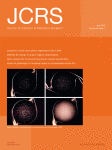 Heidelberg, 01 July 2019. The research group at the David J Apple International Laboratory for Ocular Pathology published its latest findings in this month’s edition of the renowned Journal of Cataract & Refractive Surgery
Heidelberg, 01 July 2019. The research group at the David J Apple International Laboratory for Ocular Pathology published its latest findings in this month’s edition of the renowned Journal of Cataract & Refractive Surgery
How do glistenings affect the optical quality of a hydrophobic acrylic IOL?
The impact of glistenings on the optical quality of a hydrophobic acrylic intraocular lens Jan N. Weindler, Grzegorz Łabuz, Timur M. Yildirim, Tamer Tandogan, Ramin Khoramnia, Gerd U. Auffarth.Volume 45, Issue 7, 2019, Pages 1020-1025, ISSN 0886-3350, https://doi.org/10.1016/j.jcrs.2019.01.025.(http://www.sciencedirect.com/science/article/pii/S0886335019300598)
 Dr Jan Weindler.“We used an established ageing method to induce microvacuoles in thirty-eight hydrophobic acrylic IOLs. We warmed the IOLs to 45°C and then cooled them to 37°C. Image analysis of light-microscopy photographs determined the number and size of microvacuoles (MV). A classification was applied based on the glistening number per mm2: grade 0 (none), grade 1 (1-100), grade 2 (101-200), grade 3 (201-500) and grade 4 (more than 500). An optical metrology instrument was used to measure each IOL’s modulation transfer function (MTF) and Strehl ratio to evaluate the impact of glistenings on image quality.”
Dr Jan Weindler.“We used an established ageing method to induce microvacuoles in thirty-eight hydrophobic acrylic IOLs. We warmed the IOLs to 45°C and then cooled them to 37°C. Image analysis of light-microscopy photographs determined the number and size of microvacuoles (MV). A classification was applied based on the glistening number per mm2: grade 0 (none), grade 1 (1-100), grade 2 (101-200), grade 3 (201-500) and grade 4 (more than 500). An optical metrology instrument was used to measure each IOL’s modulation transfer function (MTF) and Strehl ratio to evaluate the impact of glistenings on image quality.”
Dr Grzegorz Łabuz, “We found Glistenings in all the IOLs. The mean glistening numbers ± SD (MV/mm2) in grades 1 through to 4 were 74 ± 12.7, 142 ± 22.2, 297 ± 76.2, and 1509 ± 311.9, respectively. The mean glistening sizes in grades 1 through 4 were 13.28 ± 3.85 μm, 15.88 ± 2.08 μm, 16.85 ± 3.23 μm, and 15.27 ± 2.25 μm, respectively. “
Statistical analysis showed that grades 1 through 3 did not change the optical quality. In grade 4, the MTF and the Strehl ratio were significantly affected. Dr Łabuz, remarked that this work has an important conclusion, “a limited number (<500 MV/mm2) of glistenings was found to have no effect on the IOL’s image quality. Although there were statistically significant deteriorations in the MTF and the Strehl ratio observed in lenses with dense glistenings (Grade 4), the effects found were small and are unlikely to affect the visual quality.
Prof. Gerd Auffarth, the research leader at the D J Apple Lab, commented that this level of detailed research on IOL optics showed how the Lab had changed since coming to Heidelberg. “When I worked with David Apple at the Lab in Charleston, we did important work in describing the morphological changes that clinicians were starting to seeing in post-implantation hydrophobic IOLs. But this was largely a descriptive observation of clinical images of IOLs in the eye and of explanted IOLs. Then we did not study the optical quality. Now, twenty-five years later, in Heidelberg, we are getting down to the details of how water vacuoles in the IOL polymer have an impact on the quality of the lens.”
Using Share Link– a personalized URL providing free access to the article – anyone will be taken directly to the paper on ScienceDirect. This link expires after August 17, 2019.
No signup, registration or fees are required.
Your Share Link:
https://authors.elsevier.com/c/1ZIqB39Xtp~ZRs
 Grzegorz Łabuz
Grzegorz Łabuz 
 lOL opacification after vitrectomy and gas injection
lOL opacification after vitrectomy and gas injection